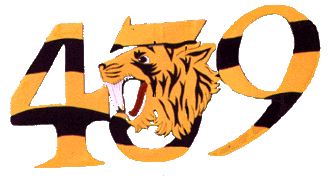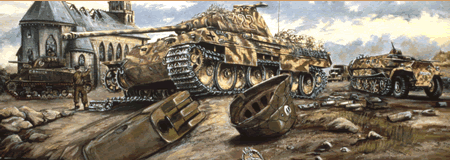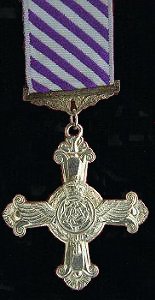|
History
of
 Squadron Squadron
  
Chapter
IV
The
Battle of Normandy
June
- August 1944
On D+1 (7 Jun) the Squadron again carried out three operations,
at 0605, 1030 and 1650 hrs., bombing and strafing enemy vehicles.
The first formation led by S/L Norsworthy, was en route to its patrol
area south of Caen when it was given a specific target, a concentration of
Nazi transport on a road south-west of that city. Dropping their bombs on a
cross-roads, the pilots "effectively
blocked" the highway and then attacked with cannons, "immobilising
and destroying about 20 trucks and three tanks." There had been virtually no flak opposition on D-Day, but the
enemy’s anti-aircraft defenses
were now getting organized
and on this sortie F/O Royce Johns’ Typhoon was nicked by a burst of 20 mm
(millimeter)
ack-ack (anti-aircraft fire).
 A segment of a powerfully portrayed painting of D-Day entitled "Whirlwind In Normandy" by Paul Seguna. © Paul Seguna, SegunArt. You can see the full painting on the next page or visiting Paul's website SegunArt . Used with permission
|
The
German gunners scored again on the second mission when W/C M.T. Judd,
DFC (Distinguished
Flying Cross),
AFC
(Air Force Flying Cross - R.A.F.), the new Wing Commander flying who
had succeeded Bob Davidson, was leading No. 439's group of eight. Near Caen airport the Winco's (Wing Commander) Tiffie was
badly damaged by flak, forcing him to jettison his bombs and return to
base. The other section
carried on, and found some vehicles which they bombed and strafed.
While doing so F/O J.A. Brown's aircraft was hit in the port (left)
wing flap. More enemy vehicles and armored
cars were sighted south of Caen on the third operation that day.
Hugh Norsworthy’s section beat up one road, while Tommy
Dadson's attacked another; four vehicles were claimed as definitely
destroyed and two more as probables.
|

Distinguished Flying Cross
Photo source: Veterans
Affairs Canada
|
Scattered
clouds that had dotted the sky on D and D+1 increased in density in the
late afternoon of the 7th until there was a complete
overcast. The morning of
the 8th was equally cloudy and an early recce patrol had to
turn back because of the low overcast which blanketed the area around
Caen. A later sortie at midday was likewise abortive as no enemy target
could be found. Then it
began to rain, and on the 9th, when the pilots were on
readiness from 0400 until dark, there was an uncomfortable drizzle. For
the next two days the weather continued to hamper operations. One job,
which had been planned for the 10th, to attack the
headquarters of the 21st Panzer Division, was washed out by unfavourable
conditions over the target. As W/C Judd landed from this abortive outing
one 500 lb. bomb became dislodged from its rack and bounced end over end
over the runway. F/O Ivan
Smith, following close behind his leader, hit the bomb with his
starboard wheel and ground-looped.
The Tiffie had the wheel torn off, but the TNT did not explode.
That evening S/L Norsworthy led a group of
eight aircraft, with two more as escort, to attack an MT (Mechanized
Transport) concentration in a wood below Caen.
Although at briefing the pilots had been told there were 150
enemy vehicles in the area, they could actually see very few. They
bombed nevertheless, but camouflage, smoke and dust prevented any
estimate of the result. Inclement weather restricted operations to one
mission on 11 June, and made it abortive.
  
|
|
 Tiger
Squadron
Tiger
Squadron 

